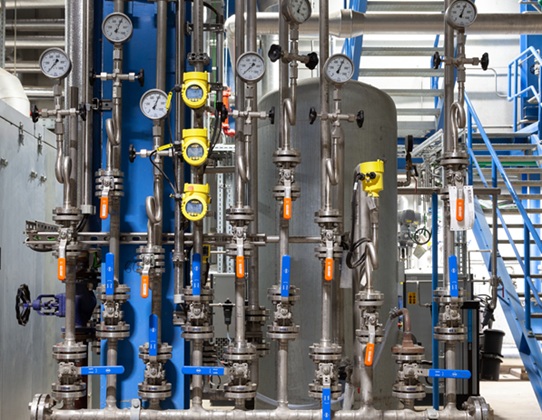Differential pressure sensors employ a metallic measuring cell at their core. This provides several significant advantages. The sensors are particularly suitable for applications that require the management of high static pressures and detection of extremely small pressure differences.

VEGABAR electronic differential pressure measurement sensors here provide steam and condensate process pressure measurement in a paper mill.
Their compact design allows for efficient integration into complex systems, and their robust construction ensures consistently high accuracy in measurements. This makes the sensors a reliable choice for environments where precision is paramount, and the slightest pressure variations must be captured and monitored.
A notable characteristic in this category, as in the CSB and CSS variants for example, is the use of chemical seals. Chemical seals are designed to enable universal application across different scenarios involving large pressure differences and high static pressures. They typically incorporate an integrated overload diaphragm, which enhances operational reliability by protecting the sensor from damage due to unexpected pressure surges. This feature is especially valuable in industrial settings where process conditions can vary unpredictably and equipment durability is essential for continuous operation.
The VEGADIF 85 is an exemplary model of a differential pressure sensor: suitable for universal application, providing high operational dependability and integrated overload protection, ensuring consistent performance in the harshest conditions, and safeguarding both the measuring cell and the integrity of the readings produced.
Electronic differential pressure measurement, on the other hand, has introduced a new level of versatility and ease of use in modern process industries. These systems typically employ two pressure transmitters – often from the VEGABAR PRO series – which are combined to form a comprehensive measurement system. One of the primary advantages of electronic differential pressure systems is their immunity to environmental factors, such as fluctuations in ambient temperature, which can otherwise compromise measurement accuracy. Additionally, electronic systems offer considerable flexibility, allowing for the use of various sensor configurations and measuring cells tailored to specific applications.
The installation, assembly, and ongoing maintenance of electronic differential pressure measurement systems are straightforward, minimising operational downtime and reducing overall lifecycle costs. In practical terms, the systems can be used for applications such as monitoring pressure overlays in vessels, where sensors from the VEGABAR 80 series are seamlessly combined. The modularity of the series means users can address challenges such as large temperature differences, vacuum conditions, abrasive media and the need for cost-efficient solutions with minimal installation complexity.
Whether you are using conventional or electronic differential pressure sensors, VEGA’s modern industrial measurement solutions offer a comprehensive suite of options designed to deliver precision, adaptability and reliability across a range of demanding applications.
For more information visit: www.vega.com/en-za